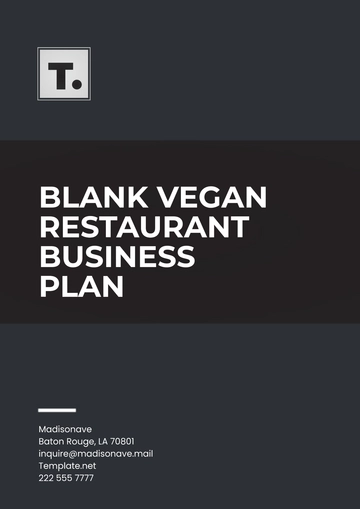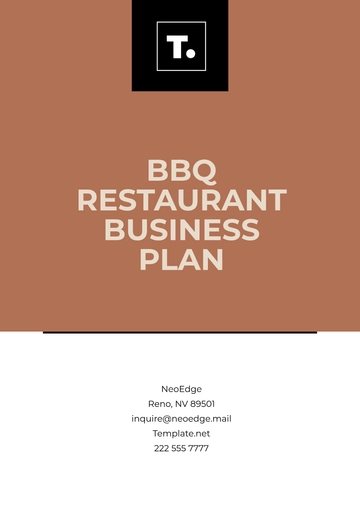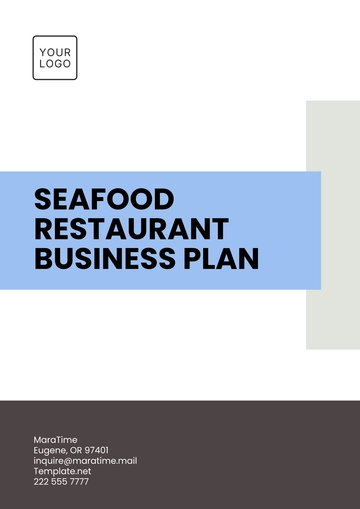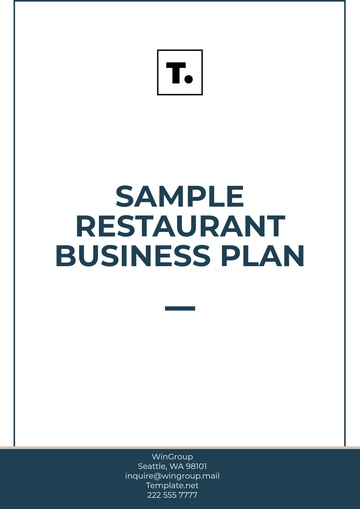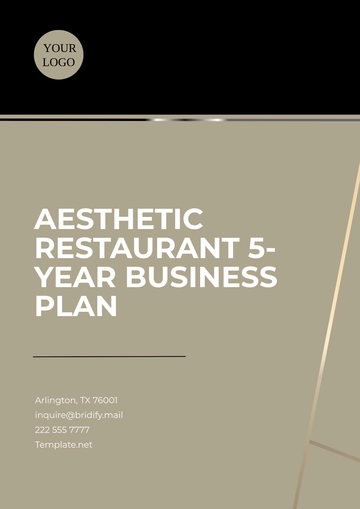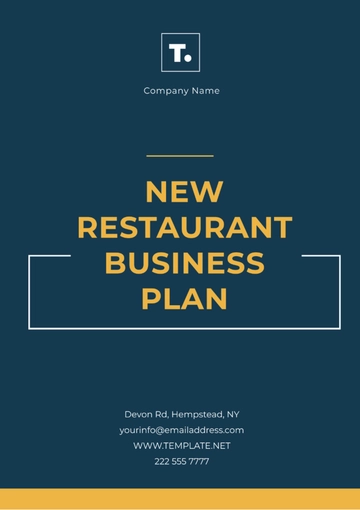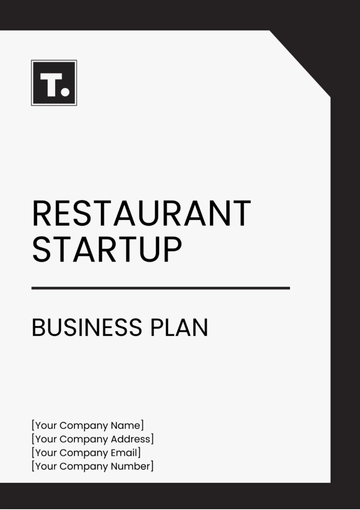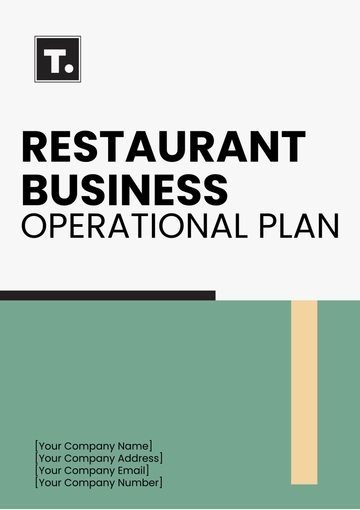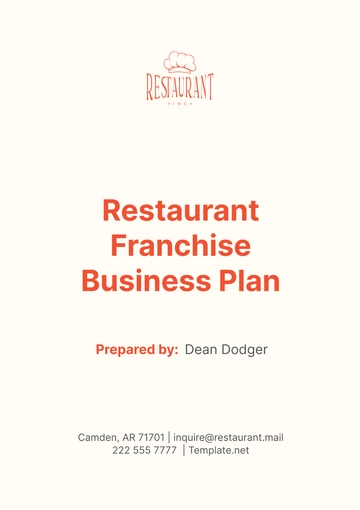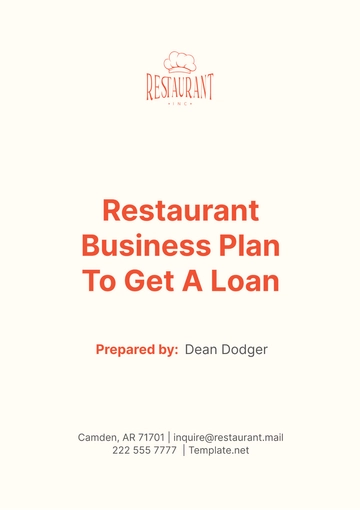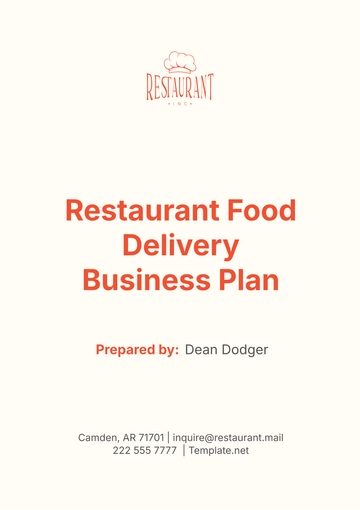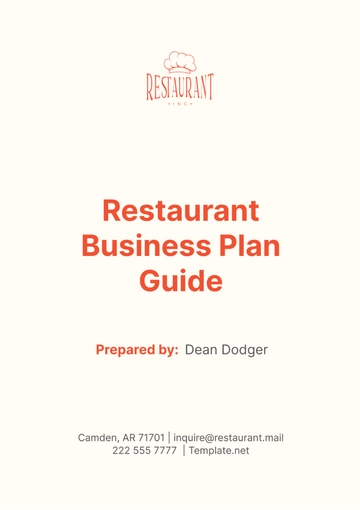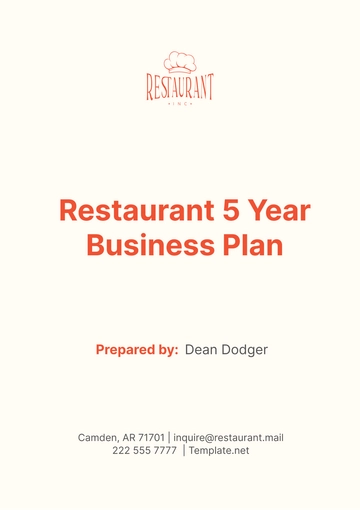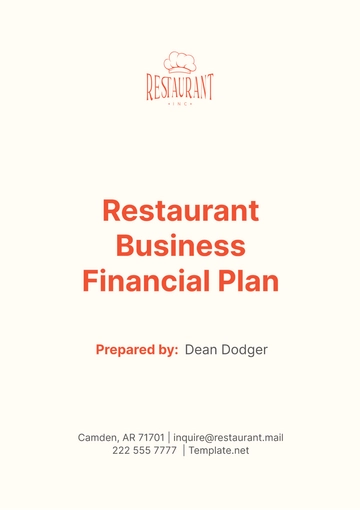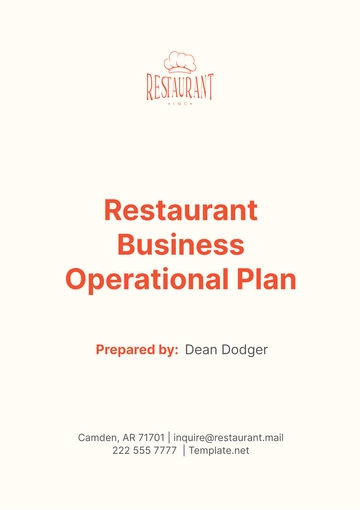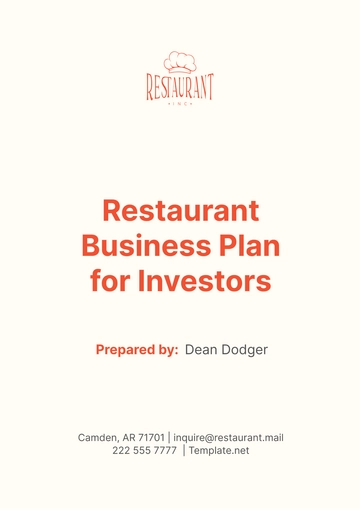Free Restaurant Franchise Business Plan
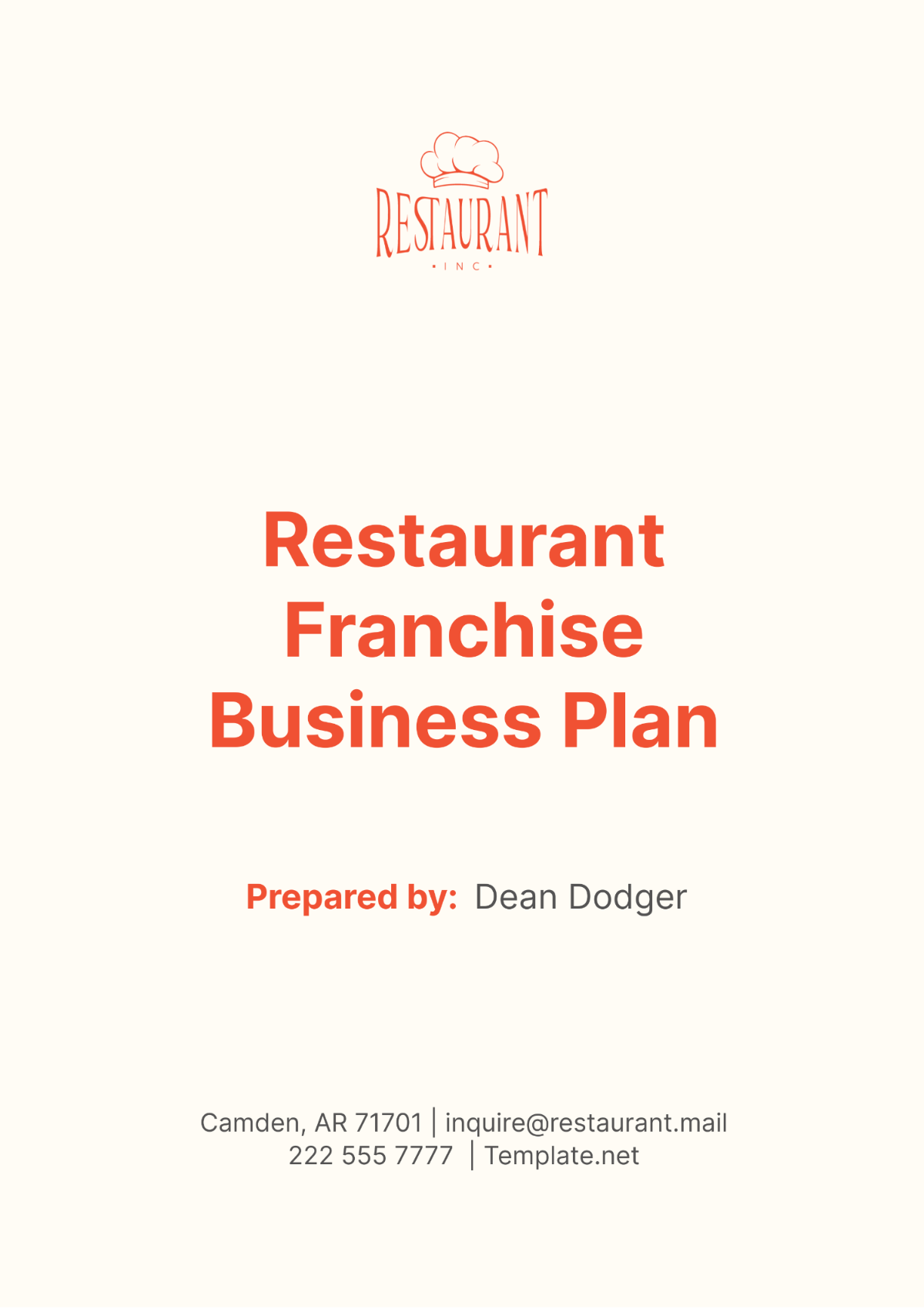
I. Executive Summary
We are a dynamic restaurant franchise specializing in gourmet burgers and craft beverages. Our concept revolves around delivering high-quality, freshly prepared meals in a vibrant and welcoming environment. Our target market includes food enthusiasts, families, and young professionals who value exceptional dining experiences.
Our business objectives are to expand our presence across key metropolitan areas, achieve consistent year-over-year revenue growth, and maintain high customer satisfaction through exceptional service and quality. We aim to open 10 new locations within the next two years, with a long-term goal of establishing a national footprint.
Key Financial Highlights
Initial Investment: $500,000 per location
Projected Annual Revenue (Year 1): $1.2 million per location
Projected Net Profit Margin: 18%
Break-Even Point: 18 months
Franchise Fee: $40,000
We began our journey with a single location that quickly became a local favorite. Our success is built on a commitment to quality, innovation, and community engagement. With a proven business model and strong brand identity, we are poised for significant growth in the competitive restaurant industry.
II. Company Description
We were founded in [Year] by a group of culinary enthusiasts passionate about creating a unique dining experience. Our first restaurant opened in a bustling urban neighborhood, quickly gaining popularity for its innovative menu and welcoming atmosphere. Over the years, we have grown organically, opening additional locations and refining our franchise model.
Our business operates as a Limited Liability Company (LLC), providing flexibility and protection for our owners. The ownership structure includes the founding partners, who are actively involved in the daily operations and strategic direction of the franchise. Our company’s success is driven by a dedicated team committed to maintaining the highest standards of quality and service.
III. Market Analysis
A. Industry Overview
The restaurant industry is a significant contributor to the global economy, with the U.S. market alone generating over $800 billion in annual sales. The fast-casual dining segment, where we operate, has been growing rapidly, driven by consumer demand for high-quality, affordable, and convenient dining options. This segment is expected to continue its upward trajectory, with an annual growth rate of 6% over the next five years. Factors such as urbanization, increasing disposable incomes, and a preference for dining out among younger demographics are fueling this growth.
B. Target Market
Our target market consists of diverse customer groups who appreciate gourmet dining experiences and craft beverages. These include urban professionals, families, and food enthusiasts aged 25-45, with a moderate to high-income level. They value quality, unique menu offerings, and a comfortable dining environment.
Demographics | Needs |
|---|---|
Age: 25-45 | High-quality, freshly prepared meals |
Income: $50,000+ | Affordable luxury dining |
Urban Professionals | Convenient locations and quick service |
Families | Kid-friendly options and comfortable seating |
Food Enthusiasts | Unique and innovative menu offerings |
C. Competitive Analysis
The fast-casual dining market is competitive, with several established players. However, our focus on gourmet burgers and craft beverages differentiates us.
Competitor | Share | Strengths | Weaknesses |
|---|---|---|---|
A | 25% | Brand recognition | Limited menu variety |
B | 20% | Marketing campaigns | Inconsistent food quality |
C | 15% | Locations | High prices |
Our restaurant stands out due to our commitment to quality, innovative menu, and exceptional customer service. We occupy a unique niche with our gourmet focus, allowing us to attract a dedicated customer base. Our market share is currently at 10%, with significant potential for growth as we expand our footprint.
IV. Franchise Concept
A. Franchise Model
Our franchise model is designed to be accessible and lucrative for franchisees. The initial franchise fee is $40,000, with a total initial investment ranging from $500,000 to $700,000, depending on the location and size of the restaurant. Franchisees are required to pay a royalty fee of 6% of gross sales and contribute 2% of gross sales to a national marketing fund.
B. Menu and Services
Our menu features a variety of gourmet burgers made with premium ingredients, alongside a selection of craft beverages. We also offer vegetarian and vegan options, ensuring inclusivity for all dietary preferences.
Gourmet Burgers (e.g., Classic Cheeseburger, Truffle Burger)
Craft Beverages (e.g., House-made Lemonade, Local Craft Beers)
Sides and Appetizers (e.g., Sweet Potato Fries, Artisan Pretzels)
Desserts (e.g., Gourmet Milkshakes, Seasonal Pies)
Vegetarian and Vegan Options (e.g., Black Bean Burger, Avocado Salad)
C. Unique Selling Proposition
Our unique selling proposition lies in our commitment to quality and innovation. We use only the finest ingredients, sourced locally whenever possible, to create a menu that is both unique and delicious. Our craft beverages complement our gourmet offerings, creating a distinctive dining experience. The ambiance of our restaurants, characterized by modern, comfortable decor, enhances the overall customer experience.
D. Location Strategy
Our location strategy focuses on high-traffic urban and suburban areas with a strong demographic fit for our target market. Ideal locations include busy commercial districts, shopping centers, and near residential communities with a high concentration of our target demographics. We prioritize accessibility, visibility, and ample parking to ensure convenience for our customers. Each location is carefully selected to maximize foot traffic and visibility, ensuring strong initial and sustained customer engagement.
V. Marketing and Sales Strategy
Our marketing and sales strategy is designed to build brand awareness, attract new customers, and foster loyalty among our existing customer base. We leverage a mix of digital marketing, traditional advertising, and community engagement to reach our target audience effectively.
Digital Marketing: Utilize social media platforms, email marketing, and search engine optimization (SEO) to reach a wider audience. Implement targeted ads on platforms like Facebook and Instagram to attract specific demographics.
Traditional Advertising: Use local print media, radio, and outdoor advertising (billboards and transit ads) to enhance visibility in key markets.
Community Engagement: Host and sponsor local events, participate in community activities, and collaborate with local businesses to build strong community ties and enhance brand reputation.
Loyalty Programs: Develop and implement a customer loyalty program that rewards repeat customers with discounts, special offers, and exclusive event invitations.
Public Relations: Engage with local media to secure press coverage and leverage influencers to review and promote our restaurant.
VI. Operations Plan
A. Operational Processes
Our operational processes are designed to ensure efficiency, consistency, and high-quality service across all locations. These processes are well-documented and standardized to maintain our brand’s reputation.
Food Preparation: Standardized recipes and preparation techniques to ensure consistency in taste and quality.
Service: Training staff to provide exceptional customer service, from order taking to table service.
Inventory Management: Regular inventory checks and a streamlined system for tracking stock levels to avoid shortages and reduce waste.
Cleanliness: Strict protocols for cleaning and sanitizing all areas of the restaurant to maintain a hygienic environment.
Safety: Comprehensive safety training for all staff, including food safety, fire safety, and first aid.
B. Supply Chain Management
We have established robust sourcing and procurement strategies to ensure the availability of high-quality ingredients and supplies. We partner with local farmers and suppliers for fresh produce and prioritize sustainability by sourcing ingredients that are organic and ethically produced whenever possible. We maintain strong relationships with our suppliers to ensure consistent delivery schedules and negotiate favorable terms to keep costs manageable.
C. Staffing Plan
Our staffing plan focuses on hiring individuals who are passionate about food and customer service. We implement a rigorous hiring process that includes background checks and multiple interviews. Training programs are comprehensive, covering everything from food preparation to customer service and safety protocols. We emphasize employee retention through competitive compensation, benefits, and opportunities for career advancement. Regular team-building activities and performance recognition help foster a positive work environment.
D. Franchise Support
We provide extensive support to our franchisees to ensure their success. This includes:
Initial Training: Comprehensive training programs covering all aspects of restaurant operations, marketing, and management.
Marketing Support: Assistance with local marketing campaigns, access to national marketing materials, and ongoing promotional support.
Operational Support: Continuous guidance and support from our operations team, including regular site visits and performance evaluations.
Technology Support: Access to our proprietary point-of-sale (POS) system and other technological tools to streamline operations and enhance customer experience.
E. Quality Control
Quality control is paramount to maintaining the high standards of our brand. We implement several measures to ensure consistency and quality across all locations:
Regular Audits: Conduct periodic audits of all franchise locations to assess compliance with our operational standards.
Customer Feedback: Encourage and actively monitor customer feedback through surveys and reviews to identify areas for improvement.
Mystery Shoppers: Use mystery shoppers to evaluate the customer experience and ensure that our service standards are being met.
Standard Operating Procedures (SOPs): Maintain detailed SOPs for all aspects of restaurant operations to ensure consistency and quality.
Training Refreshers: Provide ongoing training and refresher courses for staff to keep them updated on best practices and new procedures.
VII. Management and Organization
Our management team comprises experienced professionals with a diverse set of skills, all dedicated to the success and growth of our franchise. The organizational structure is designed to support efficient decision-making and ensure that all aspects of the business are effectively managed.
Role | Responsibilities |
|---|---|
CEO | Oversees overall strategic direction |
COO | Manages operations and ensures operational efficiency |
CFO | Handles financial planning, budgeting, and reporting |
Marketing Director | Develops and implements marketing strategies |
Franchise Manager | Provides support and guidance to franchisees |
Head Chef | Oversees menu development and kitchen operations |
HR Manager | Manages recruitment, training, and employee relations |
IT Manager | Maintains and supports technology systems |
VIII. Financial Plan
A. Startup Costs
The initial investment required to open a new franchise location includes several key expenses. Below is a detailed breakdown of the startup costs.
Expense Category | Cost (USD) |
|---|---|
Franchise Fee | $40,000 |
Real Estate and Leasehold | $150,000 |
Equipment and Furnishings | $100,000 |
Initial Inventory | $30,000 |
Marketing and Promotion | $20,000 |
Training and Support | $20,000 |
Working Capital | $140,000 |
Miscellaneous | $40,000 |
Total | $500,000 |
B. Revenue Projections
Our revenue projections for the first five years are based on conservative estimates and industry benchmarks.
Year | Projected Revenue (USD) |
|---|---|
1 | $1,200,000 |
2 | $1,500,000 |
3 | $1,800,000 |
4 | $2,100,000 |
5 | $2,400,000 |
C. Profit and Loss Statement
Our projected profit and loss statement outlines the expected profitability of the franchise over the first five years.
Year | Revenue (USD) | COGS (USD) | Gross Profit (USD) | Operating Expenses (USD) | Net Profit (USD) |
|---|---|---|---|---|---|
1 | 1,200,000 | 600,000 | 600,000 | 450,000 | 150,000 |
2 | 1,500,000 | 750,000 | 750,000 | 500,000 | 250,000 |
3 | 1,800,000 | 900,000 | 900,000 | 550,000 | 350,000 |
4 | 2,100,000 | 1,050,000 | 1,050,000 | 600,000 | 450,000 |
5 | 2,400,000 | 1,200,000 | 1,200,000 | 650,000 | 550,000 |
D. Cash Flow Statement
The projected cash flow statement indicates the expected cash flow from operations, investing, and financing activities over five years.
Year | Operating Cash Flow (USD) | Investing Cash Flow (USD) | Financing Cash Flow (USD) | Net Cash Flow (USD) |
|---|---|---|---|---|
1 | 200,000 | (300,000) | 250,000 | 150,000 |
2 | 300,000 | (100,000) | 0 | 200,000 |
3 | 400,000 | (50,000) | 0 | 350,000 |
4 | 500,000 | (50,000) | 0 | 450,000 |
5 | 600,000 | (50,000) | 0 | 550,000 |
E. Break-Even Analysis
Our break-even analysis shows that the franchise is expected to break even within 18 months of operation. The break-even point is achieved when total revenues equal total expenses.
Break-Even Revenue: $900,000
Break-Even Units Sold: 45,000 meals
Time to Break-Even: 18 months
F. Funding Requirements
We require an initial investment of $500,000 to cover the startup costs of each new franchise location. Below is a breakdown of the funding requirements. Potential sources of financing include bank loans, private investors, and franchisor financing options. We are also exploring opportunities for government grants and subsidies for small businesses. Our goal is to secure funding through a combination of these sources to minimize risk and ensure the financial stability of our franchisees.
- 100% Customizable, free editor
- Access 1 Million+ Templates, photo’s & graphics
- Download or share as a template
- Click and replace photos, graphics, text, backgrounds
- Resize, crop, AI write & more
- Access advanced editor
Plan your expansion with the editable and customizable Restaurant Franchise Business Plan Template from Template.net. This comprehensive template covers all essential sections for a successful business plan. Editable in our AI Editor tool, it allows you to tailor each section to your specific franchise goals. Ensure a clear and professional business strategy with this thorough and user-friendly template.
You may also like
- One Page Business Plan
- Coffee Shop Business Plan
- Restaurant Business Plan
- Food Business Plan
- Real Estate Business Plan
- Executive Summary Business Plan
- Cover Page Business Plan
- Nonprofit Business Plan
- Daycare Business Plan
- Construction Business Plan
- Startup Business Plan
- Medical Business Plan
- Bakery Business Plan
- Service Plan
- Hotel Business Plan
- Catering Business Plan
- School Business Plan
- Healthcare Business Plan
- Transportation Plan
- Sports Plan
- Car Wash Business Plan
- Salon Business Plan
- Clothing Business Plan
- Farming Business Plan
- Boutique Plan
